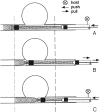Preliminary experience with Leo self-expanding stent for the treatment of intracranial aneurysms
- PMID: 16286403
- PMCID: PMC7976185
Preliminary experience with Leo self-expanding stent for the treatment of intracranial aneurysms
Abstract
We report initial experience with the use of a new intracranial stent, the Leo microstent in combination with detachable coils in treatment of patients with wide-necked cerebral aneurysms. The Leo stent represents a significant advance in the vascular treatment of intracranial aneurysm with high radial force and an easy delivery system. It is a feasible, secure, and effective system.
Figures







References
-
- Howington JU, Hanel RA, Harrigan MR, et al. The Neuroform stent, the first microcatheter-delivered stent for use in the intracranial circulation. Neurosurgery 2004;54:2–5 - PubMed
-
- Fiorella D, Albuquerque FC, Han P, et al. Preliminary experience using the Neuroform stent for the treatment of cerebral aneurysms. Neurosurgery 2004;54:6–17 - PubMed
-
- Benitez RP, Silva MT, Klem J, et al. Endovascular occlusion of wide-necked aneurysms with a new intracranial microstent (Neuroform) and detachable coils. Neurosurgery 2004;54:1359–1368 - PubMed
-
- Sani S, Jobe KW, and Lopes DK. Treatment of wide-necked cerebral aneurysms with the Neuroform2 Treo stent. Neurosurg Focus 2005;4:1–5 - PubMed
MeSH terms
LinkOut - more resources
Full Text Sources
Other Literature Sources
Medical
